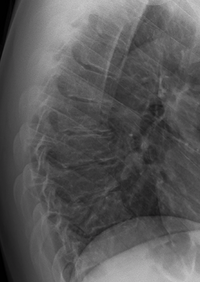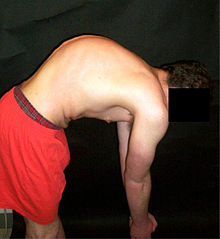| Scheuermann's disease | |
|---|---|
| Other names | Scheuermann's kyphosis, Calvé disease, idiopathic juvenile kyphosis of the spine |
 | |
| Scheuermann's disease on lateral Xray of the T spine | |
| Pronunciation |
|
| Specialty | Orthopaedics, Rheumatology Osteopathy, Chiropractic |
| Symptoms | Curve of upper back, chronic pain |
| Complications | Chronic pain, lower than average bone density hence greater risk for osteoporosis and osteopenia[1] |
| Usual onset | Adolescence |
| Duration | Lifelong |
| Causes | Unknown, Genetic factors |
| Diagnostic method | X-ray, MRI |
| Treatment | Physical therapy, avoiding excessive weight bearing exercises, back brace, surgery |
| Prognosis | Self-limiting |
| Prevalence | It has a prevalence of 0.4–8.3% in the population with a higher incidence in Males |

Scheuermann's disease is a self-limiting skeletal disorder of childhood. Scheuermann's disease describes a condition where the vertebrae grow unevenly with respect to the sagittal plane; that is, the posterior angle is often greater than the anterior. This uneven growth results in the signature "wedging" shape of the vertebrae, causing kyphosis. It is named after Danish surgeon Holger Scheuermann.[3][4][5]
- ^ Chen Y, Bloomfield A, Nasir A (10 March 2017). "Scheuermann's disease". Statistics Canada. Retrieved 17 January 2021.
- ^ Gaillard, Frank. "Scheuermann disease | Radiology Reference Article". Radiopaedia.org. Retrieved 25 April 2022.
- ^ Scheuermann's disease at Who Named It?
- ^ Cite error: The named reference
r4was invoked but never defined (see the help page). - ^ Cite error: The named reference
urlMedcyclopaedia - Scheuermanns diseasewas invoked but never defined (see the help page).